We’ve all been there: moments when self-doubt creeps in, or when we shy away from opportunities that could lead to personal growth. Whether it’s procrastinating on important tasks, avoiding uncomfortable situations, or questioning our abilities, these actions often hold us back from achieving our true potential. This is the core of self-sabotage—when our behaviors prevent us from reaching our goals, even though we genuinely want to succeed. It’s a common yet often misunderstood phenomenon that affects every area of our lives, from our careers to relationships, personal goals, and overall well-being.
Self-sabotage happens when we take actions that actively hinder our progress. It’s the moment you delay starting a crucial project until the last minute, pick unnecessary fights with a supportive partner, or convince yourself not to apply for your dream job because “you probably wouldn’t get it anyway.” These behaviors can seem small, but over time, they can build barriers between you and your aspiration for growth.
So, why do we sabotage ourselves, and more importantly, how can we break free from these harmful patterns? In this article, we’ll delve into the psychological signs and reasons behind “why do we self sabotage” and share practical strategies to help you recognize, manage, and overcome it—so you can stop holding yourself back and start unlocking your full potential.
What is self-sabotage?
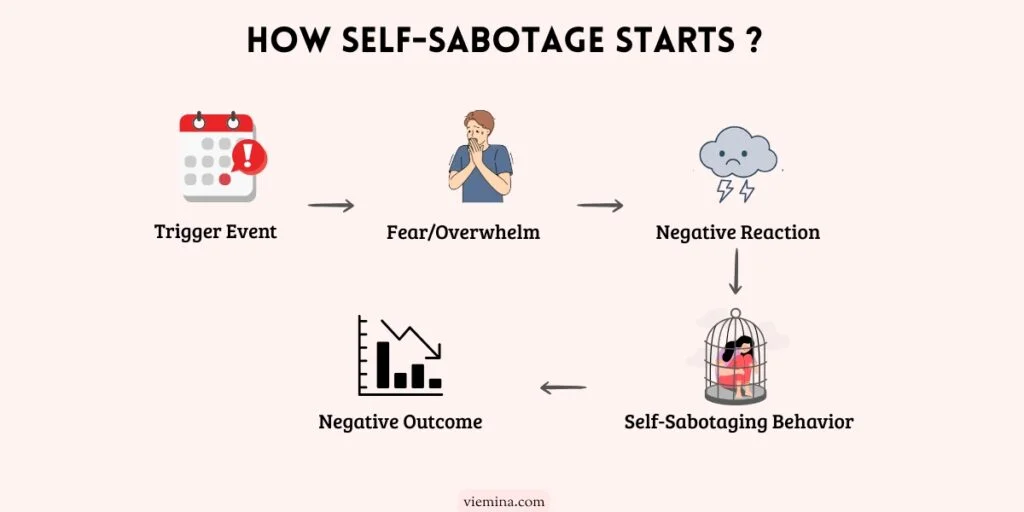
Self-sabotage behavior shows up when your actions create problems in daily life and get in the way of your long-term goals. You might think these behaviors are always on purpose, but they often happen without you even noticing. The word “sabotage” sounds intentional, but people rarely block themselves from getting what they want on purpose – yet they find ways to trip themselves up.
This strange behavior pattern pops up in many areas of life and quietly affects your career growth, relationships, and personal growth. The tricky part about self-sabotage is that you might not see how your actions lead to self-defeating results right away.
The science behind self-sabotage tells us something interesting. Dr. Judy Ho explains in her book “Stop Self-Sabotage” that self-destructive behavior works like a biological response. Your brain releases dopamine when you set goals, but fear kicks in when it’s time to finish them. This “approach-avoidance conflict” explains why you might start projects with excitement but drop them before finishing.
Self-sabotage also happens when your values don’t match your actions. You either do something that doesn’t fit what you really want, or you know your goals but take steps that lead nowhere.
Why Do We Self Sabotage?
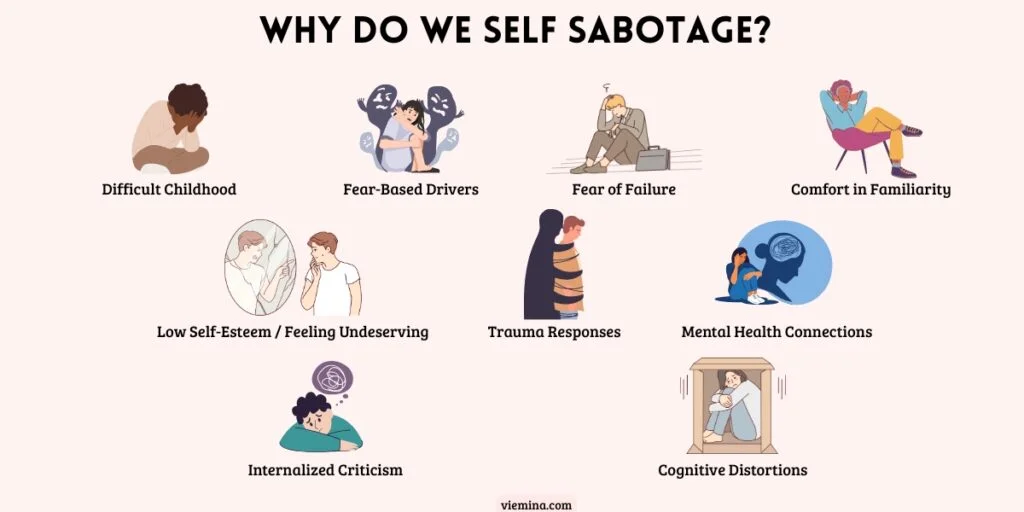
Understanding the psychology behind self-sabotage is crucial for overcoming it. Let’s explore the major underlying causes:
1-Difficult Childhood:
Your childhood experiences shape self-sabotaging behaviors fundamentally. Kids who grow up in dysfunctional families often develop insecure attachment patterns that follow them into adulthood. Parents who remain emotionally unavailable, detached, or critical can make their children believe relationships aren’t safe or that they don’t deserve success. Many adults recreate familiar patterns of failure or disappointment that feel “safe” in a strange way.
Related: 23 Signs of Repressed Childhood Trauma in Adults
2- Fear-Based Drivers:
Fear drives most self-defeating behaviors. People fear success as much as failure, which can leave them paralyzed. Success brings change, and change means uncertainty. So they might sabotage opportunities to keep things the same, even when their current situation makes them miserable.
Related: 10 Tips to overcome fear and become unstoppable
3-Fear of Failure:
Self-sabotage often serves as a protective—mechanism against the pain of failure. By creating circumstances that ensure failure, we maintain control over the outcome and protect ourselves from the disappointment, shame, or embarrassment that might come with giving our best effort and still falling short.
Dr. Ellen Hendriksen, clinical psychologist and author of “How to Be Yourself,” explains: “When we sabotage ourselves, we’re trying to protect ourselves. Paradoxically, self-sabotage is actually self-protection gone awry.”
Related: Why Do I Feel Like a Failure? 20 Causes That Might Shock You
4-Comfort in Familiarity:
For many people, failure, struggle, or disappointment is familiar territory.
Dr. Nicole LePera, clinical psychologist, notes: “We often recreate patterns that feel familiar to us, even when they’re painful. There’s comfort in what we know, even if what we know doesn’t serve us.”
5-Low Self-Esteem / Feeling Undeserving:
If you fundamentally believe you don’t deserve happiness, success, or love, you might unconsciously take actions to confirm this belief. Psychologists call this “cognitive consistency”—our behaviors tend to align with our self-image, even when that image is negative.
Related: Low Self Esteem: 10 Effective Ways to Improve Self-Worth
6-Trauma Responses:
Did you know that unhealed trauma can lurk behind those self-sabotaging habits you just can’t seem to shake? It’s like a form of self-protection that sticks around even when it’s no longer necessary.
According to trauma expert Dr. Bessel van der Kolk, “The body keeps the score”, meaning those past traumas are still hanging out in our bodies and nervous systems, shaping our actions in ways we might not even realize.
Related: 7 Stages of Trauma Bonding: Effects, Causes & How to Heal
7-Mental Health Connections:
Sometimes, self-sabotage can be connected to conditions like ADHD, anxiety, depression, or PTSD. For instance, challenges with executive function related to ADHD can make it tough to stay on track, and depression can worsen negative thoughts that drive self-defeating behaviors.
Why do we self-sabotage? That question alone can open the door to real change. Understanding why these patterns exist is the first step toward breaking free from them. As Dr. Judy Ho, neuropsychologist and author of Stop Self-Sabotage, puts it:
“Self-awareness doesn’t guarantee change, but it makes change possible.”
Related: What Are The 5 Stages Of PTSD: All What You Need to Know
Related: What Are the 17 Symptoms of Complex PTSD?
8-Cognitive Distortions:
Thinking patterns like catastrophizing, black-and-white thinking, or overgeneralization can fuel self-sabotage by distorting our perception of reality and reinforcing negative beliefs about ourselves and our capabilities.
9-Internalized Criticism:
Many of us grow up absorbing the critical voices of parents, teachers, or society, and over time, those voices can turn into our own inner critic, always second-guessing us and chipping away at our confidence.
Related: 21 signs of Manipulative parents
Related: 18 Signs of a Manipulative Mother
Related: 12 Signs Of An Unhealthy Relationship
Common Signs of Self-Sabotage:
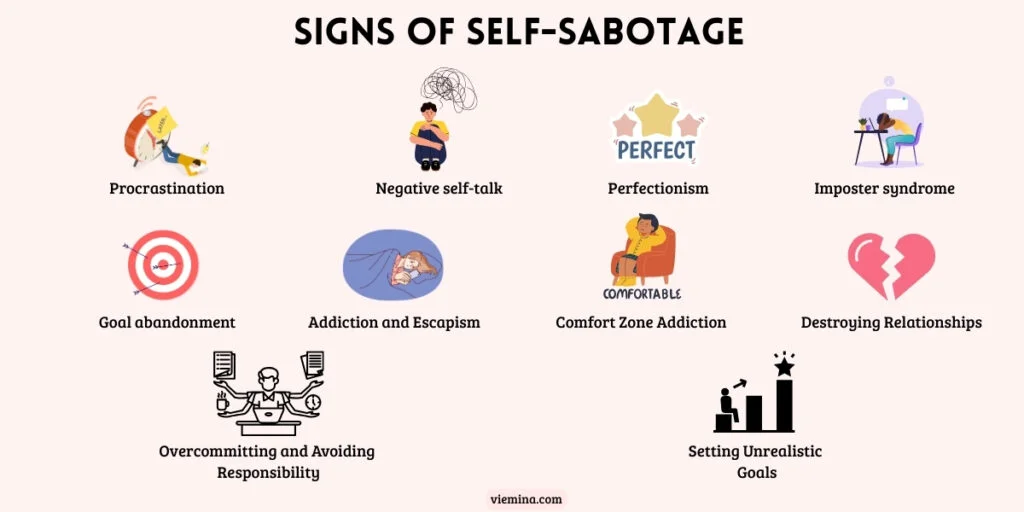
Breaking free from destructive patterns starts with spotting them first. Self-sabotage usually works below our conscious awareness, which makes it tough to spot. You’ll learn about what holds you back once you understand these warning signs.
1-Procrastination:
Chronic procrastination is probably the most common way people sabotage themselves. This isn’t about putting things off now and then — it happens when you keep delaying important work even though you know it matters. You might clean your desk instead of tackling that big presentation, or scroll through social media as deadlines get closer. People often do this because they’re afraid of failing, succeeding, or what others might think.
Related: How To Overcome Procrastination: 12 Tips To Boost Focus
2-Negative self-talk:
Negative self-talk can both cause and show self-sabotage. Your inner voice might say things like “I’ll never get this right” or “Why even try?” This harsh inner critic hurts your confidence and makes you believe less in yourself. The worst part? These negative thoughts often come true — you expect to fail, and then create situations where you do.
Related: The Toxic Effects of Negative Self-Talk ’11 Effects’
3-Perfectionism:
Perfectionism is another way we trip ourselves up. You sabotage yourself when you won’t turn in work unless it’s “perfect” or quit projects that don’t meet impossible standards. This creates a situation where nothing feels good enough, and your goals stay unfinished.
Related: How To Overcome Perfectionism in 10 Tips
4-Imposter syndrome:
Imposter syndrome both causes and results from self-sabotage. You might downplay achievements or avoid recognition when you feel like a fraud despite being competent. This keeps feeding your feelings of not being good enough, no matter what you achieve.
Related: Imposter Syndrome Symptoms & 10 Tips to Overcome It
5-Goal abandonment:
Happens when you start projects with excitement but quit before finishing them (Abandoning goals at the first sign of difficulty). This pattern leaves behind many half-done projects that damage your self-trust. Conflict creation is about stirring up drama when things are peaceful, which ruins success without you realizing it.
6-Addiction and Escapism:
Addiction and escapism often manifest in habits like alcohol, drugs, binge-watching, or endless scrolling on social media. These behaviors serve as coping mechanisms, providing temporary relief from emotional pain or stress by numbing us to uncomfortable feelings or situations. Rather than facing difficult emotions or challenges, we turn to these distractions as a way to avoid confronting what’s truly bothering us, which only perpetuates the cycle of self-sabotage.
Related: How to Break Bad Habits and Stop Your Addiction ? ’15 tips’
Related: 8 Tips For Healthy Social Media Habits
7-Comfort Zone Addiction:
Refusing to step outside familiar territory, even when it limits your growth
Related: Stepping Out of Your Comfort Zone: 20 Unique Tips for Growth
8-Destroying Relationships:
Pushing people away, starting fights, or testing boundaries can be a way to “prove” you’re unlovable. It’s painful—and avoidable.
Related: Relationships
9-Overcommitting and Avoiding Responsibility:
Avoiding responsibility—through missed deadlines, blaming others, or playing the victim—prevents growth by dodging accountability. Similarly, overcommitting by saying yes to everything can be a form of self-sabotage, as it often leads to burnout and failure. Both behaviors keep us stuck, masking deeper fears and hindering progress.
10-Setting Unrealistic Goals:
Setting unrealistic goals sets you up for failure. When your objectives are impossible to achieve, it’s easy to fall short and use that as proof of your doubts, telling yourself, “See? I knew I couldn’t do it.” This self-sabotage keeps you trapped in a cycle of discouragement, preventing genuine progress and growth.
How to Stop Self-Sabotaging Yourself?
1- Increase Self-Awareness:
Let’s be honest—most of us have gotten in our own way at some point. You set a goal, things start going well… and then, for some reason, you pull back, procrastinate, or mess it up (I experience this a lot). Sound familiar?
That’s self-sabotage. And the first step to changing it is learning to notice when it’s happening.
Start by paying attention. Not in a harsh or judgmental way—just observe and ask yourself:
- When do I usually start throwing up roadblocks for myself?
- What emotions come up right before I do something that works against my goals?
- What thoughts go through my head right before I’m about to make real progress?
- What am I actually afraid of—success, failure, being seen?
These kinds of questions aren’t about overanalyzing everything. They’re just a way to bring more awareness to your patterns. The more you notice, the more you can shift.
Self-sabotage usually doesn’t show up out of nowhere. There’s almost always a trigger—a feeling, situation, or thought that sets it off. Maybe you’re afraid that things are going too well. Possibly you’re worried you’ll fail and look foolish. Or maybe deep down, success feels unfamiliar or uncomfortable.
Whatever the reason, once you’re aware of your personal triggers, you can start making different choices. That might mean taking a breath before reacting, changing how you talk to yourself, or creating small habits that keep you grounded when those old patterns try to creep in.
This kind of awareness isn’t a one-time thing. It’s a practice. But it’s a powerful one.
2- Challenge the Beliefs Behind Self-Sabotage:
Once you start recognizing your patterns, the next step is to question the beliefs and fears driving them.
Your mindset shapes the way you show up in the world. So when self-doubt sneaks in—as it does for all of us—try to pause and reframe it. Not every thought that crosses your mind is true—or worth believing.
For example:
Instead of: “I’m going to fail.”
Try: “I’m capable of learning and improving.”
You don’t have to force toxic positivity—just aim for a more balanced, supportive perspective.
And also, if you faced Hidden Fears. Ask yourself:
“If I succeed, then…”
“If I fail, then…”
Your answers can reveal limiting beliefs like, “If I succeed, people will expect more, and I’ll disappoint them.” Once you’re aware of these thoughts, you can start challenging them.
When you catch a negative belief, pause and ask:
What’s the real evidence for this?
Is there another way to view this?
How would I support a friend in this situation?
If fear is holding you back, break it down:
- Define the worst-case scenario.
- Ask how you could prevent or prepare for it.
- Figure out how you’d recover.
- Look at the possible benefits of trying.
- Consider the cost of staying stuck.
The more you work on reframing your thoughts and understanding your beliefs, the stronger you become in overcoming self-sabotage. Awareness creates choice—and choice creates change.
Once you’ve done that, the next step is taking full responsibility for your choices. Instead of blaming circumstances or others, you take ownership of your actions. And that’s when things start to shift—when you begin making intentional choices that align with your goals.
3-Set Realistic Goals:
Setting realistic goals helps you avoid feeling overwhelmed and giving up before you start. When your goals are too big or unclear, it is easy to feel stuck or lose motivation. Instead, set goals that match your current skills, time, and energy. A great way to do this is to use the SMART method—make your goals Specific, Measurable, Achievable, Relevant, and Time-bound.
For example, rather than saying “I want to get fit,” try “I’ll do a 20-minute workout at home every weekday after work for the next month.” Breaking big goals into smaller steps makes them feel less scary and way more doable.
It also helps to focus on what you can do each day, instead of stressing about the final result. Small steps add up over time, and every bit of progress counts.
“Don’t forget to celebrate those little wins—they keep you motivated and moving forward.”
4-Embrace imperfection and grow through setbacks:
Embracing imperfection is a powerful way to overcome self-sabotage and advance with confidence. Perfectionism and fear of failure can prevent it, but the truth is – the mistakes are part of growth. Instead of seeing failure as the end of the road, try to see it as feedback. Ask yourself:
- What can I learn from this?
- How can this help me grow?
- What would I do differently next time?
These questions turn setbacks into stepping stones. If you catch yourself self-sabotaging, don’t beat yourself up. Start by acknowledging what happened without judgment. Then, identify what need you were trying to meet—whether it was security, control, comfort, or something else—and consider how you might meet that need in a healthier, more effective way next time. Finally, forgive yourself and make a conscious choice to move forward. Growth isn’t about being perfect—it’s about learning, adjusting, and continuing
Related: Embracing Imperfection: 9 Top Steps to Self-Acceptance
5-Visualize Success:
Visualization is a powerful tool to break free from self-sabotage and approach your goals. Take a few quiet moments every day to imagine yourself succeeding – live the life you want, appearing with confidence and overcoming challenges with ease. Imagine yourself acting, keeping your focus, and celebrating your progress. When you consistently view success, it helps reformulate your subconscious mind to believe it is
possible. This simple practice can increase your motivation, create self-confidence, and create the positive mindset needed to continue, even when things get difficult.
Related: Mindset
6-Challenge Negative Self-Talk:
Negative internal dialogue can feed self-sabotage, undermining your trust and self-esteem. Whenever you get involved in negative internal conversation, challenge these thoughts with positive statements. Replace self -critical statements with more empowering, such as “I am capable of”, “I deserve success” and “I can overcome any obstacle.” By changing your internal dialogue, you can change your behavior.
Related: The Toxic Effects of Negative Self-Talk ’11 Effects’
7-Practice Self-Care:
Taking care of your physical, emotional and mental well-being is essential to overcome self-sabotage. Make self-care a priority by sleeping enough, eating a balanced diet, exercising regularly and getting involved in activities that bring you joy. When you prioritize self-care, you build resilience against self-sabotations trends and enhance your overall well-being.
📔 Start your self-care journey today — get the Self-Care Planner and take the first step toward a healthier mindset.
Related: ⬇
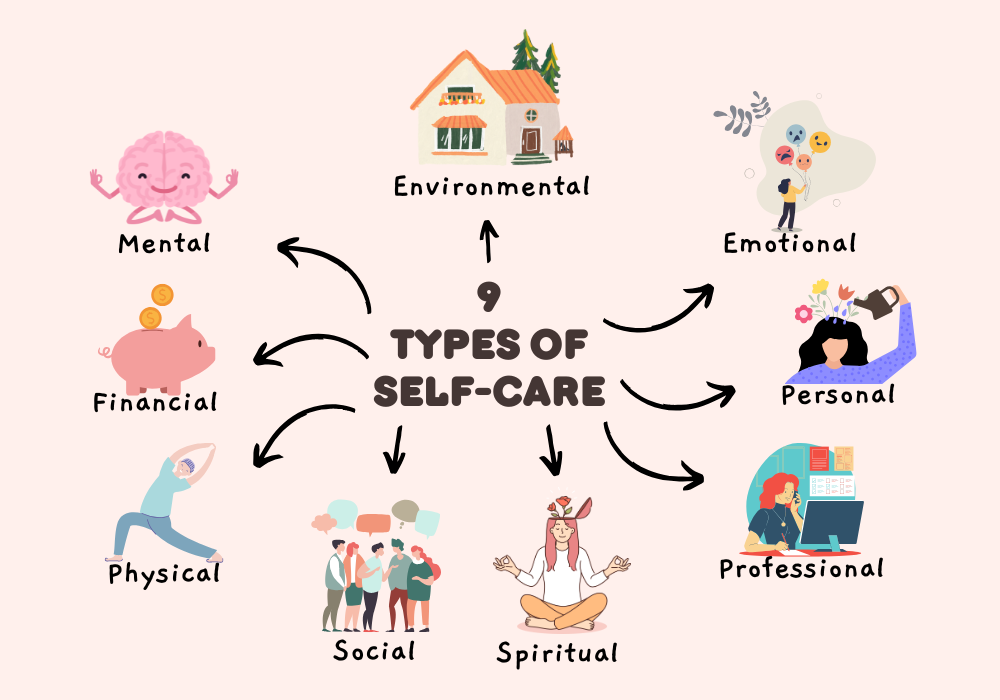
8-Develop Healthy Coping Mechanisms:
A lot of the time, self-sabotage happens because of stress, anxiety, or things we’ve been through in the past. Instead of falling into old, unhealthy habits, it’s so much more helpful to focus on ways to cope that actually help us move forward. Things like mindfulness, meditation, exercise, or even therapy can make a huge difference when you’re dealing with tough emotions.
A helpful exercise to try, it can help you :
Create a simple two-column list:
In the first column: Jot down the factors that typically trigger your self-sabotaging behavior.
In the second column: Brainstorm healthier ways to react to these triggers. This could involve taking a stroll, practicing deep breathing, or reaching out to a friend for support.
You can also try building some positive habits, like:
- Moving your body—whether it’s walking, doing yoga, or dancing to your favorite song.
- Doing deep breathing or relaxing your muscles when stress starts to build.
- Using creative outlets—like writing, drawing, or painting—can be a powerful way to clear your mind and process what you’re feeling.
- Spending time with people who uplift you, or simply getting outside and connecting with nature.
- Use mindfulness as a way to anchor yourself in what’s real—right here, right now.
And don’t forget, having a solid support system is key. Let the people who care about you—whether it’s friends, family, or even a coach or therapist—know what you’re working on, and ask for the kind of support you need, whether it’s encouragement, accountability, or just someone to talk to when things get tough.
Talking openly about your struggles can help you gain new perspectives and insights.
9-Seek Professional Support:
Sometimes it does not matter how hard we put in the work, we seem to hit the same walls over and over again. If self-sabotage is getting in the way of your life, keeps resurfacing no matter how hard you try to change things, or feels connected to something more deep-seated like emotional pain or mental health struggles—it might be time to reach out for help. Seeing therapists or coaches does not reflect any weakness; it is a step towards showing bravery.
The right support can guide you in the right direction to heal these damaging cycles: what is really happening at the layers deeper than your consciousness, why it is happening, and how to deal with it constructively.
Conclusion:
Embracing change and breaking free from self-sabotage isn’t about striving for perfection. It’s about building a more compassionate, self-aware connection with yourself. Every time you recognize an old behavior and choose differently, you’re actually rewiring your brain and paving the way for fresh opportunities.
Change takes time. So be gentle with yourself as you unlearn habits that may have been part of your life for years—maybe even decades. The process can be challenging, but the freedom that comes from no longer standing in your way? That’s worth every bit of effort.
What self-sabotaging pattern will you start working on today? Feel free to share your thoughts—opinions in the comments, and thank you so much for reading!
FAQ about Self-Sabotage:
Is self-sabotage a mental illness?
No, self-sabotage itself is not classified as a mental illness. It’s a pattern of behavior that can show up in anyone’s life. However, persistent self-sabotage may sometimes be connected to mental health conditions like anxiety, depression, PTSD, or personality disorders. If self-sabotaging behaviors significantly impact your quality of life, consulting with a mental health professional can help determine if there are underlying conditions that need addressing.
Can self-sabotage be unconscious?
Yes, self-sabotage is often unconscious. Many people aren’t aware they’re undermining their own success until they recognize patterns of repeated setbacks. Our brains are wired to protect us from perceived threats, including the emotional risks of failure, success, or change. These protective mechanisms can operate beneath our conscious awareness, making them particularly challenging to address without deliberate self-reflection.
What is the root cause of self-sabotage?
While self-sabotage has multiple potential causes, most stem from fear and self-protection. Common root causes include fear of failure or success, low self-worth, negative core beliefs formed in childhood, trauma responses, and learned patterns from family dynamics. Self-sabotage often begins as an adaptive response to protect ourselves from emotional pain, disappointment, or vulnerability, but becomes maladaptive when it prevents healthy growth and fulfillment.
How do I know if I’m self-sabotaging?
Signs of self-sabotage include recurring patterns of undermining your goals, feeling stuck in cycles of progress followed by setbacks, procrastinating on important tasks, experiencing relationship difficulties that follow similar patterns, feeling anxious when close to success, making decisions that conflict with stated goals, and having a persistent gap between your potential and your achievements.
If you’ve ever looked back at your actions and thought, “Why did I do that?”—there’s a chance self-sabotage might be behind it.
What’s the difference between self-sabotage and procrastination?
Procrastination is actually one form of self-sabotage, but not all self-sabotage involves procrastination. Procrastination specifically means delaying tasks, even when you’re aware that doing so might lead to negative outcomes. Self-sabotage, on the other hand, is a broader concept. It can show up as perfectionism, critical self-talk, damaging relationships, or setting yourself up to fail.
While procrastination is largely about avoiding action, self-sabotage includes any behavior that gets in the way of your goals or overall well-being.


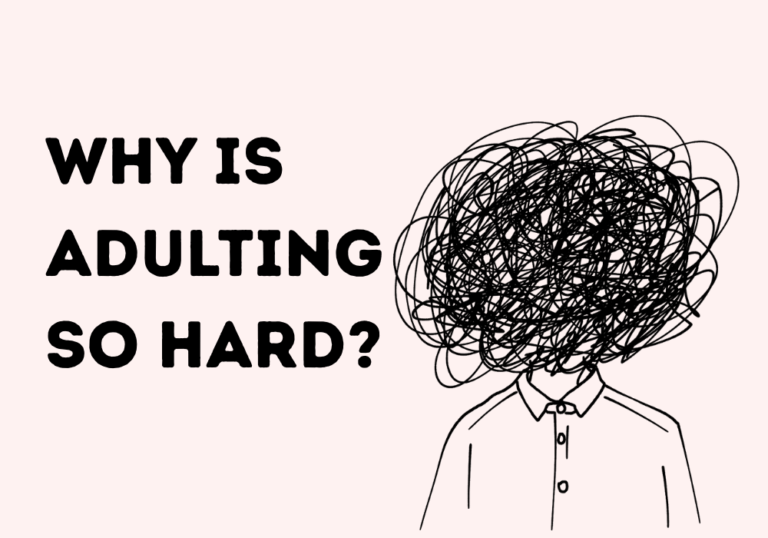






Good post. I learn something totally new and challenging on sites I stumbleupon everyday. It will always be helpful to read content from other writers and practice a little something from other websites.